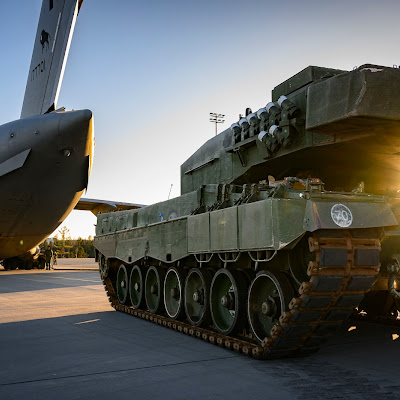By Stijn Mitzer and Joost Oliemans
The Islamic State's rise to the status of one of the most sophisticated designated terrorist groups ever to exist has been accompanied by an unprecedented level of ingenuity, especially considering the fact that most of their sites and weaponry were quickly targeted by Air Forces operating over the conflicted battlespaces of Syria and Iraq. In an attempt to address this threat the Islamic State resorted to desperate measures such as using conventional artillery as makeshift anti-aircraft guns, relying on the remote chance of achieving a direct hit on enemy aircraft flying high in the sky to bring them down.
First shown off by the Islamic State in March 2016, these truck-mounted 122mm D-30 howitzers
of the Al-Farouq Platoon (of the Wilayat Ninawa Air Defence Battalion) were seen
firing at U.S. Navy (E)P-3 spy planes used for signals intelligence
(SIGINT) missions over Mosul. The use of this weaponry, ordinarily used
as conventional artillery against ground targets only, is highly
notable, and highlights the Islamic State's severe lack of means to
counter the Coalition's overwhelming air assets.
The
images, captured in and around Mosul, the largest city to have been
captured by the Islamic State (IS), depict U.S.-made Navistar International
7000 Series and M936 trucks that have been modified to carry the
Soviet-legacy 122mm D-30 howitzer. Over a hundred Navistar 7000 series and an unknown number of M936 wreckers were captured by IS when its forces took control over Mosul in June 2014. In contrast, Syria appears to have been the source of the 122mm D-30 howitzers, where around fifty fell in Islamic State since 2014.
While most arms captured by IS were destined for use in the region or country they were captured in, the Islamic State moved large quantities of arms between the areas it controlled in Syria and Iraq. Examples of these are the transfer of large numbers of M16 assault rifles from Iraq to Syria, where they were apparently favoured over the ubiqitous AK-pattern of rifles, and the movement of Syrian T-55 tanks to Iraq, where they were employed in the defence of Mosul in 2016 and 2017.
The M936-based howitzer (seen in the header image) appears to have been housed in a hardened aircraft shelter (HAS) at Mosul airport, only being moved outside when a potential target appears. Furthermore, the truck has been outfitted with stabilisers and a mount to lower the howitzer into travel position.
Also shown are two shots fired by the truck mounted howitzers missing their intended target: A U.S. Navy (E)P-3 Orion signals reconnaissance aircraft. These secretive aircraft are used by the Navy for intelligence gathering and electronic warfare along and over the territory of adversaries and enemies, sometimes leading to near-misses and even a collision with aircraft aiming to intercept them.
The slow-flying (E)P-3s, usually flying in a circular pattern, must have been a thorn in the eye of the Islamic State, which, in contrast with fast flying jets also used in the region, must appear as though they have a chance of shooting them down. Despite the fact that the high-powered artillery is capable of reaching the altitude at which these aircraft operate, the fact that their High Explosive (HE) munition lacks any type of proximity- or anti-aircraft fuse means they have to score a direct hit on their target in order to disable it, an almost impossible feat to accomplish.
Although this practise might appear to be a waste of time and precious munition, the Islamic State is not the first to resort to such tactics. Indeed, Mujahideen are known to have employed mortar- and RPG-fire against Soviet helicopters during the Soviet invasion of Afghanistan, and Iranian artillery targeted low-flying Iraqi helicopters during the Iran-Iraq War as well. Of course, neither of these cases resulted in any reported aircraft losses or even minor damage being done, as the use of such desperate tactics only results in either a complete destruction of the target or a complete miss.
Recommended Articles:
This was the Islamic State's Beast of Mosul
See the Mobile Battle Fortresses Islamic State used around Mosul
Massive Earthmover Turned Into An Earthbraker VBIED By Islamic State
Armour in the Islamic State, the Story of 'The Workshop'
Armour in the Islamic State, the DIY works of Wilayat al-Khayr

.png)











